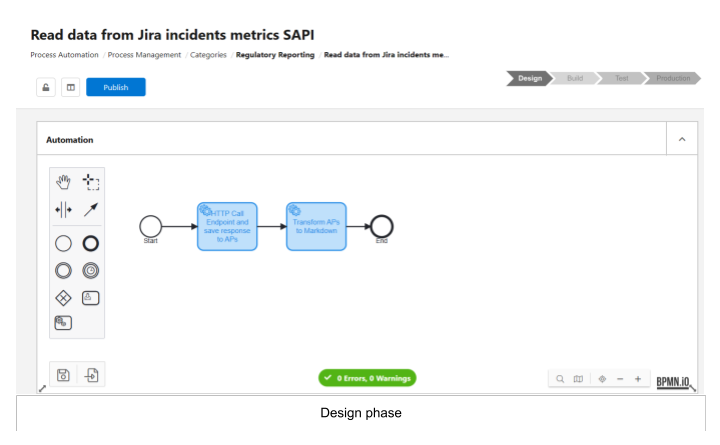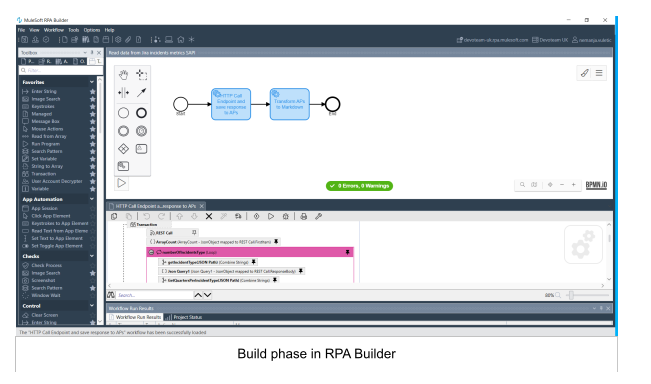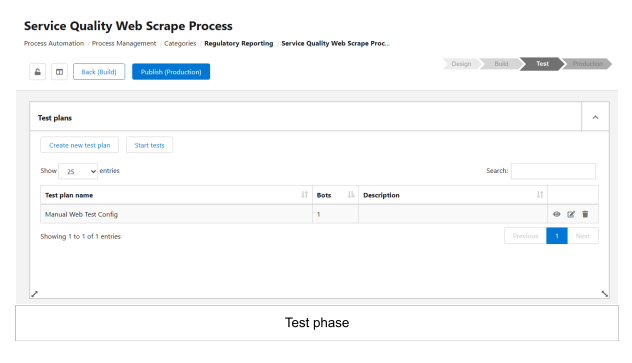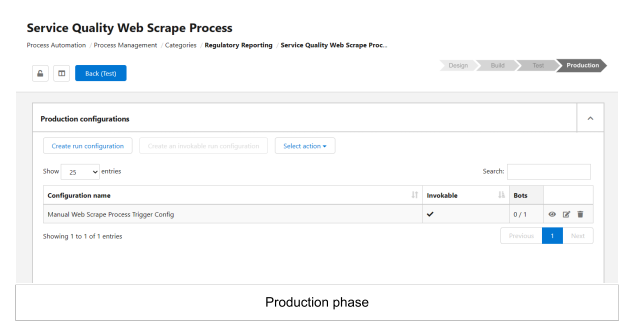What is RPA?
RPA stands for Robotic Process Automation, a software technology that combines robotics and automation to perform repetitive tasks. Boosting your productivity with MuleSoft’s RPA bot is as simple as instructing a machine to execute tasks. If there is a logical step to perform it, MuleSoft’s RPA bot can replicate it.
RPA mimics and minimises the activity of a human in carrying out a task within a process. It can complete repetitive tasks more quickly, accurately and tirelessly than a human, giving them more productive time.
How does RPA work?
RPA tools can record users performing tasks and generate a script the bot follows to perform the mentioned tasks.
An RPA script mimics the clicks, entries, movements and overall actions the user performs on the screen. For example, some steps may require logging into different applications where we need to open it, log into that app, perform steps and activities and exit.
MuleSoft RPA
MuleSoft RPA is a modern enterprise platform for process automation, providing user-friendly no-code tools and powerful robotics technology for successful process automation. Every automation project passes the entire RPA lifecycle.
The Anypoint Platform, an integration platform for SOA, SaaS, and APIs, has been extended to include MuleSoft RPA. RPA processes can be invoked directly from MuleSoft Composer, thus powering complete end-to-end automation.
Here are some key benefits:
- Powering end-to-end automation in combination with MuleSoft APIs.
- Unlocking data from legacy systems without APIs.
- Freeing the workforce by automating many of the manual and repetitive tasks.
- Staying in control of the automated process – centrally managed and governed.
- Seamless integration with MuleSoft APIs, MuleSoft Composer and Salesforce.
MuleSoft RPA Usage?
MuleSoft RPA enables us to do various automation activities:
- Automate data entry and data retrieval in legacy and modern applications
- Extract data from documents, web pages, emails, spreadsheets, and more
- Intelligently recognise and extract texts from images and screens
- Orchestrate complex multi-step, multi-system workflows
In my experience with RPA, I dealt with matters related to the finance and banking sector. The research topic was regulatory reporting, and our vision was to automate the creation of the reports. We utilised RPA to automate the extraction of specific data in CSV format, perform web screen scraping tasks and get incident information from Jira.
At first, working with RPA was a challenge because, for my colleagues and me, RPA was an unexplored area which seemed quite limited. Working with RPA, we encountered several problems related to the abovementioned implementations. I’ve covered them below:
- Logging in with 2 step verification
We have been unable to solve this and turned off the 2-step verification. The process contained steps for recognising images and objects on the screen, including clicking and entering text. Therefore the process was very demanding (the processor utilisation was 100%). - Iterating over csv files and getting values
The process was complex. We had to read the entire file to determine its length. Then reread the file, this time line by line. We introduced a separator to transform each line into an array. Subsequently, we obtained the array’s length, enabling us to iterate through its contents and retrieve values.
This was a long and complicated process and required a lot of time to perform a simple task. We can only imagine how long it would take to perform more complicated tasks or extract much larger files this way. - Triggering the RPA process
When using RPA Manager’s run configuration with scheduler invocation, we ran into a problem. MuleSoft Composer component “Trigger: On RPA Process Execution Completed in MuleSoft RPA” doesn’t register RPA process completion if the scheduler triggers the process – manual run configurations work fine.
Composer can only start and query invokable processes, i.e. only with invokable run configuration. Composer cannot start or query the scheduled run configuration. The status of processes which were started from a scheduled run configuration cannot be retrieved by Composer.
We had to introduce another process that the scheduler would trigger. Its task is to invoke the REST service of the subsequent RPA process in our sequence, thereby triggering it. After the CSV RPA process completes its actions, the composer will generate a report in Google Sheets and then trigger the following RPA process. - Unreliable recognition of objects on the screen
When similar things were on the screen, the RPA often made recognition mistakes and set the mouse cursor in inadequate positions to perform specific actions (clicking, scrolling, entering text…). The recognition process could have been more reliable (it would always read certain words differently)
RPA Lifecycle
Source: MuleSoft
Here is the simple representation of the MuleSoft RPA Lifecycle:
Evaluation enables us to assess whether or not a given process will be worth automating.
- In the design phase, we can design all steps necessary to have complete coverage of the process to be automated.

- The build phase is to create workflows and apply logic to the steps designed in the previous steps so that a bot can understand and execute them.

- In the Test phase, the automated processes are validated to verify stability.

- Once stable, they can be deployed into production.

RPA Builder
RPA Builder is the on-premise development environment that enables us to build automations by specifying the tasks and steps of the process.
With RPA Builder, we can;
- import a BPMN(Business Process Model and Notation) diagram generated in RPA Manager,
- drag and drop operations from the left-side toolbox or record keyboard and mouse input to specify the action steps,
- perform local testing of our workflow,
- and when we finish building the process, we upload it to RPA Manager to move on to the testing phase.
RPA Builder enables us to:
- Download and upload automation assets to RPA Manager.
- Add the automation logic to the processes.
- Run local tests for the automations.
Benefits of RPA
- Efficiency: RPA is widely recognised for its ability to boost productivity among enterprise employees by reducing the time spent on repetitive tasks. According to Gartner, RPA can save up to 30% of a full-time employee’s overall work time.
- Accuracy: Automation through RPA ensures higher accuracy in data entry tasks compared to manual execution. RPA tools can also guarantee 100% compliance with industry and organisational policies, minimising errors and enhancing data integrity.
- Cost savings: By improving employee productivity, RPA enables organisations to save money. With less time spent on repetitive tasks, employees can focus on more valuable and strategic work, maximising their output within the same timeframe.
- Integration with legacy technology: Many organisations still rely on legacy systems that pose challenges when integrating with modern cloud-based solutions. RPA provides a convenient entry point by leveraging the user interface to seamlessly transfer data to and from legacy systems, bridging the gap between outdated and contemporary technologies.
Challenges of RPA
- Display human workers: One of the criticisms of RPA and other automation technologies is their potential to eliminate the need for data entry and clerical-style roles, thus impacting human employment.
Potential solutions:
– Repurpose and upskill employees for higher-value tasks.
– Emphasise collaborative automation to work alongside humans. - Lack of intelligent capabilities: RPA is limited to performing tasks based on predefined scripts when used as a standalone technology. It cannot learn and improve the scripts it executes. To overcome this, the next generation of AI and intelligent automation tools are being introduced, aiming to address this pitfall of RPA by incorporating advanced learning and adaptation capabilities.
Potential solutions:
– Adopt next-generation AI and intelligent automation tools.
– Integrate machine learning and cognitive technologies into RPA systems. - Project complexity: Transformative RPA projects often involve complexity and require a significant time commitment to realise the return on investment. Consequently, some RPA projects fail to deliver value before being fully implemented and leveraged.
Potential solutions:
– Implement RPA incrementally for quicker results.
– Involve stakeholders, provide training, and manage change effectively.
The MuleSoft RPA Bot is a robust solution for automating processes. It offers end-to-end automation, user-friendly tools, and seamless integration with MuleSoft APIs.
While facing challenges like verification bypass and object recognition, the benefits of boosting your productivity with MuleSoft’s RPA bot include increased efficiency, accuracy, cost savings, and integration with legacy systems.
By adopting MuleSoft RPA, organisations can streamline operations, enhance productivity, and pave the way for digital transformation.
If you would like to learn more about this, don’t hesitate to get in touch with one of our experts.
